
|
Sale 31
Pre-Long Beach Coin Auction
| Literature-Colonial Coins |
| |
| |
| Lot |
Photo |
Description |
Realized |
Lot 1 |
|
R.S. Yeoman. A Guide Book of United States Coins 1947-2004. A complete set of "Red Books" starting with the 1st Edition 1947 thru the 57th Edition 2004. The key 1st, 2nd and 3rd Editions are all quite nice and grade Very Fine, the balance grade Very Fine to Mint. The later editions which were issued in both soft and hard bound are mostly hard bounds. Lot of 57 books.
Estimated Value $1,500 - 2,000.
View details
| Realized
$1,840 |
Lot 2 |
 |
Colonial & Early USA era counterstamped gold coinage. In the pre-revolutionary and early independence period, Brazilian gold coins of 6400 Reis colloquially known as "Joes", as many were issued under the reign of Joseph I of Portugal, were used as currency in the USA and some Caribbean islands under British rule. As so many were clipped, damaged or otherwise underweight, they were often plugged with gold inserts to bring them up to proper weight standards and then counterstamped by the certifying goldsmiths to confirm the weight and gold content. Here is just such a specimen. It is a Brazilian 6400 Reis dated 1751 minted at Rio De Janeiro, which has been plugged to bring it to a gross weight of 13.99 grams. The normal issued weight of the 6400 Reis was 14.3436 grams so this coin could have been underweight originally or possibly the plug removed was of greater weight than the plug replaced. It is counterstamped on the reverse "WH", which is the personal mark of William Hollingshead who is known to have first been in business in 1754. He conducted trade at the corner of Arch and 2nd Streets in Philadelphia until 1785. The host coin is in attractive Extremely Fine condition with the c/s about As Struck. A very rare and important artifact relative to early American numismatics and monetary history.
Estimated Value $10,000 - 15,000.
View details and enlarged photos
| Realized
$18,975 |
Lot 3 |
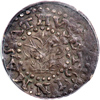 |
1662 Oak Tree Twopence. PCGS graded EF-40 PQ. Breen-36, with large 2 in the date. Weight 10.8 grams. Well struck and toned. The twopence denomination was authorized May 16, 1662 and were to be coined for a period of not more than seven years. Only one pair of dies were used with the reverse being continually re-engraved to remove a crack. Population of 14 with 28 finer (PCGS # 17) .
Estimated Value $5,000 - 6,000.
View details and enlarged photos
Check results on similar lots
| Unsold |
Lot 4 |
 |
1652 Pine Tree Shilling. Large planchet. . Breen-42. PCGS graded AU-58 PQ. A most interesting and attractive specimen centered slightly to the lower left on the obverse. The tree is well defined with each branch and leaf clear. The reverse is equally bold and both sides are handsomely toned in bluish gray with the occasional golden highlight. Slight evidence of die clashing and reworking of the dies. Die steel for coinage was quite scarce in early America, thus dies were used and re-used to strike desperately needed coinage. When a die cracked or broke, it was repaired by either lapping down the surfaces or re-engraving the devices. Population 12. There are also 2 in 61, 4 in 62, 3 in 63 and one coin in 64.
One of the first colonies established during the colonial period, was the Massachusetts Bay Colony. As the population grew, the need for coinage as a circulating medium grew. In the 1630s a loose barter system prevailed, any hard currency (copper, silver or gold) was siphoned off to Britain through both taxes and by selling the colonists goods at inflated prices. Purchases were made by trading goods for goods: furs, fish, grain, musket balls, wampum, shells, etc. The only coins in circulation in Massachusetts at the time were outdated English farthings and some Spanish silver, which would have been used by passing merchant ships and buccaneers stopping by Boston as a port of call. King Charles I of England was executed, and his forces were defeated by 1651, thus the royal regulations governing the Colony were no longer relevant. The General Court of the Massachusetts Bay Colony authorized John Hull and Robert Saunderson to strike much needed silver in the denominations of XII Pence (one Shilling), VI Pence and III Pence in mid 1652. The first coinage was the NE coinage, followed a year later by the Willow Tree pieces, later the Oak Tree coinage and finally the various Pine Tree issues. The date 1652 was continuously used for decades, as the Colony had no authority to continue to strike its own coins. Later, when King Charles II was restored to the English throne, he allowed the coinage to continue after paying the taxes due. Many of the large size Oak Tree and Pine Tree pieces were bent and toothmarked as witch tokens, as the superstitious local citizenry of the time believed that carrying such a coin would offer protection from witches. Clipping and shaving for illegal profit was also rampant. From 1675, coiner Hull made the planchets smaller and thicker, to make the coins harder to bend and clip, though shaving continued. Massachusetts silver coins are among the most important colonial issues, as they were the first silver coins struck in the continental United States. They circulated widely, including Canada and were obliquely invloved in one of the earliest colonial revolts against the mother country when in 1684 the British revoked the charter of the Massachusetts Bay Colony, and with it their coinage right (PCGS # 23) .
Estimated Value $9,000 - 11,000.
View details and enlarged photos
Check results on similar lots
| Realized
$12,190 |
Lot 5 |
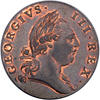 |
1773 Virginia Halfpenny. Period after "GEORGIVS". PCGS graded MS-64 Red & Brown. A very handsome specimen, fully struck and with lovely color. The surfaces are pale mahogany with mint red (especially on the reverse) nicely highlighting the design aspects. Sure to please the lucky winning bidder! (PCGS # 240) .
Estimated Value $1,000 - 1,300.
View details and enlarged photos
Check results on similar lots
| Realized
$1,150 |
Lot 6 |
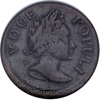 |
1760 Voce Populi Halfpenny. "VOOE POPULI". NGC graded VF-30 Brown. Scarce "VOOE" variety with the C of VOCE appearing as an O. It is possible that the C was first engraved backwards, with the subsequent correctly placed C masking the original misplaced serif of the C. Perhaps the O was used twice and a C was engraved over it in an attempt to correct the mistake. Whatever the case, the present coin has light brown color with slightly porous surfaces. While struck off-center, all the lettering is present and sharp (PCGS # 265) .
Estimated Value $300 - 350.
View details and enlarged photos
Check results on similar lots
| Realized
$312 |
Lot 7 |
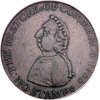 |
1766 Pitt Halfpenny Token. PCGS graded VF-35. A better than average strike with milk chocolate brown surfaces which are remarkably clean with no signs of porosity or verdigris often seen on this issue. Truly a superior and most pleasant specimen for the type and grade (PCGS # 236) .
Estimated Value $1,200 - 1,500.
View details and enlarged photos
Check results on similar lots
| Realized
$1,380 |
Lot 8 |
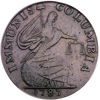 |
1787 Immunis Columbia. Copper pattern. PCGS graded EF-45. Well struck for this issue. The surfaces are glossy in medium mahogany color and exceptionally free of serious defects. Pop 6 in this grade with 20 higher, the nicest being two pieces in MS-63. Though this coinage is well known, the statutes authorizing their issuance is not. The eagle reverse may be a model for subsequent federal coinage and some were struck after the 1787 date seen on the obverse. A scarce and desirable colonial issue, and a specimen which could easily surpass our estimate (PCGS # 841) .
Estimated Value $4,000 - 5,000.
View details and enlarged photos
Check results on similar lots
| Realized
$4,485 |
Lot 9 |
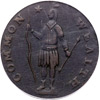 |
1788 Massachusetts Cent. PCGS graded VF-30. Sharpness finer than VF. Housed in an old PCGS green label holder. The word CENT bold in shield. Slightly porous planchet. Even dark brown color with tan high points (PCGS # 311) .
Estimated Value $350 - 400.
View details and enlarged photos
Check results on similar lots
| Realized
$368 |
Lot 10 |
 |
New York. 1796 Castorland Medal in silver. Restrike. Proof 63. The French Castorland settlement of the 1790s (or "Beaverland" as castor is the french word for beaver) was near present day Watertown, New York. Yeoman's Red Book tells us that these pieces "were given to directors of the colonizing company for their attendance at board meetings", but it is not clear whether they were considered as cash payment to the directors or merely souvenirs. Bowers, while discussing the Garret specimen conjectures that they "were possibly intended to circulate at the value of a half dollar, for the size and weight is similar to the standard United States issue of the time." The obverse depicts a veiled female head left wearing a laurel wreath and a small mural crown. Immediately below is the artists name as DUV. (Duvivier). The surrounding legend is "Franco-Americana Colonia" with "Castorland 1796" in the exergue. On the reverse is a standing female figure holding a cornucopia next to a maple tree with a beaver below and latin legend around. This specimen is a Paris Mint restrike in silver with the appropriate markings, and is of older vintage as the more current restrikes have a more modern look to them. Sharply struck with pale golden toning near the edges (PCGS # 61124) .
Estimated Value $400 - 500.
View details and enlarged photos
Check results on similar lots
| Unsold |
Lot 11 |
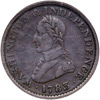 |
1783 Washington token. Large military bust. PCGS graded VF-35 (PCGS # 667) .
Estimated Value $225 - 250.
View details and enlarged photos
Check results on similar lots
| Realized
$204 |
|
|